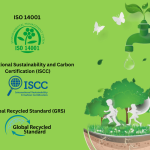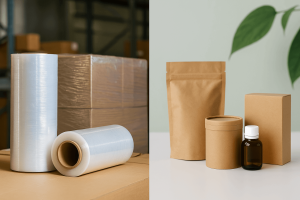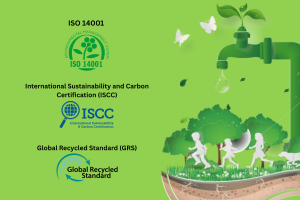
In today’s packaging industry, sustainability is no longer a buzzword—it’s a business imperative. Companies are under growing pressure to meet environmental standards, reduce plastic waste, and deliver sustainable packaging solutions without compromising performance. That’s where Post-Consumer Recycled (PCR) Stretch Film steps in.
Among the leaders in this shift is PCR Film, a stretch film solution that balances environmental responsibility with high-performance load containment. But what exactly is PCR stretch film? How does it differ from traditional recycled stretch film? And why should you care?
Let’s break it all down in this educational and friendly guide to help you make informed, eco-conscious packaging decisions.
What is Post-Consumer Recycled (PCR) Material?
Post-consumer recycled (PCR) materials are derived from plastic products that have already served their intended use and have been diverted from landfills through collection and recycling programs. Think water bottles, used stretch wraps, grocery bags, or packaging films that consumers throw away after use.
These plastics are:
- Collected through recycling channels,
- Cleaned and sorted,
- Processed into resin (PCR resin),
- And then converted into new products—like PCR packaging and stretch film.
By incorporating PCR resin into packaging solutions, manufacturers significantly reduce the use of virgin plastics and lower their environmental footprint.
PCR Film vs Recycled Stretch Film: What’s the Difference?
It’s common to hear “recycled stretch film” and “PCR stretch film” used interchangeably, but they’re not always the same. While both incorporate recycled content, the source material, processing, and performance levels differ significantly.
Let’s explore what sets PCR apart—and why Maxstretch Regen PCR Film, a 30% post-consumer recycled high-performance stretch film, leads the charge in balancing sustainability and stretch film performance.
What is Traditional Recycled Stretch Film?
Traditional recycled stretch film is typically made from post-industrial recycled (PIR) materials. These are manufacturing scraps and waste from production lines—clean, unused material that gets reintegrated back into the film extrusion process.
Key Characteristics of PIR-Based Recycled Film:
- Source: Factory floor waste, edge trims, roll rejections
- Processing: Easier to control as the material hasn’t been contaminated
- Quality: Consistent and relatively high due to known origin
- Sustainability Impact: Reduces internal waste, but does not address the larger issue of post-consumer plastic pollution
While PIR recycled film supports internal waste reduction and lowers raw material cost, it does not close the loop on the plastic lifecycle or directly reduce landfill contributions.
What is PCR Stretch Film?
Post-consumer recycled (PCR) stretch film, on the other hand, is made using plastics that have already gone through the consumer chain. These include:
- Discarded shrink wraps
- Grocery bags
- Used pallet films from distribution centres
- Agricultural or retail plastic films
The recovered plastics are cleaned, reprocessed into PCR resin, and incorporated into stretch films through advanced co-extrusion technologies.
Key Characteristics of PCR-Based Stretch Film:
- Source: Collected consumer plastic waste
- Processing: More complex (sorting, decontaminating, re-pelletising)
- Quality: Historically variable, but new tech like in Maxstretch Regen has overcome this
- Sustainability Impact: Closes the loop—directly contributes to a circular economy and waste diversion from landfills
This type of recycled content is increasingly recognised in environmental regulations and corporate ESG initiatives as a positive step toward sustainable packaging practices.
Feature | PCR Stretch Film | Traditional Recycled Film |
Source | Post-consumer plastics (e.g. used packaging) | Often from post-industrial waste (factory scraps) |
Environmental Benefit | Diverts waste from landfills, circular economy | Reduces internal waste, less landfill impact |
Performance Reliability | High (with proper formulation & tech) | Moderate to high (depending on % used) |
Quality of Resin | Requires advanced processing for consistency | Usually easier to control in production |
Ideal Use | High-performance, eco-conscious packaging | Cost-saving, general use |
Maxstretch Regen PCR Film stands out because it’s specifically formulated using high-quality PCR resin, offering reliable load stability while supporting your sustainability goals.
Introducing Maxstretch Regen: 30% PCR, 100% Performance
Maxstretch Regen PCR Film is a next-generation solution that sets a new benchmark in the industry. It is engineered with 30% post-consumer recycled content, offering a responsible choice that delivers reliable performance for high-load applications.
Unlike older recycled films that often compromised on tensile strength and load stability, Maxstretch Regen is manufactured using:
- Precision blending of PCR resin with premium virgin materials
- Advanced multi-layer extrusion for strength, clarity, and puncture resistance
- Strict quality standards to ensure consistent wrapping efficiency
This means you get the sustainability benefit of using 30% recycled plastic—without sacrificing the security of your palletised goods.
Why Choose Maxstretch Regen PCR Film?
When it comes to choosing the right stretch film for your operations, Maxstretch Regen doesn’t make you pick between performance and sustainability—it gives you both.
1. High Load Containment Strength
Despite its recycled content, Maxstretch Regen performs comparably to virgin stretch films. It provides:
- Excellent puncture resistance
- High stretchability
- Secure load containment
This means fewer film breaks and better protection in transit—even for heavy or irregular pallet loads.
2. Reduces Carbon Footprint
Using PCR resin reduces the need for virgin plastic production, which in turn cuts:
- CO₂ emissions
- Energy consumption
- Petroleum resource use
In short, it’s a smart choice for companies tracking toward carbon neutrality or ESG (Environmental, Social, Governance) goals.
3. Supports Global Sustainability Goals
Switching to Maxstretch Regen helps align your brand with global initiatives such as:
- The UN Sustainable Development Goals (SDGs)
- The EU Packaging and Packaging Waste Directive
- Corporate net-zero plastic or recycled content policies
This can also support your company’s marketing and reporting requirements on environmental performance.
How Is PCR Stretch Film Made?
Creating high-performance PCR stretch film like Maxstretch Regen requires advanced extrusion and blending technology. Here’s a simplified process overview:
- Post-consumer plastics are collected and sorted.
- These are washed, shredded, and reprocessed into PCR pellets (resin).
- The PCR resin is blended with select virgin resins or performance additives.
- The blend is extruded into stretch film using multi-layer co-extrusion to ensure consistency, strength, and clarity.
This results in a film that looks and performs close to conventional stretch film—while contributing to a circular economy.
Is PCR Stretch Film Right for Your Business?
If your business is aiming to reduce plastic usage without compromising on packaging integrity, the answer is yes.
Here are ideal scenarios where Maxstretch Regen PCR Film adds value:
- You have corporate sustainability reporting to fulfil.
- Your products require secure pallet wrapping for long-distance transport.
- You want to minimise plastic tax or EPR (Extended Producer Responsibility) penalties in certain markets.
- You aim to reduce total plastic footprint without risking product damage.
How Do You Make the Switch to PCR Stretch Film?
Transitioning to PCR stretch film is easier than you think. Here’s how to get started:
1. Evaluate Your Current Usage
Audit your current stretch film consumption, load types, and wrapping processes.
2. Test Maxstretch Regen
Get sample rolls for internal testing. Our technical team can help run film trials to benchmark performance against your current solution.
3. Implement in Phases
Start with high-volume SKUs or warehouses with strong ESG targets.
4. Communicate the Impact
Track data on carbon savings, plastic reduction, and cost per pallet wrapped. Share these results with internal stakeholders and in external sustainability communications.
Final Thoughts
Using post-consumer recycled stretch film can offer environmental benefits while still meeting performance requirements. With solutions like Maxstretch Regen PCR Film, businesses can secure their loads, lower their plastic use, and move toward their sustainability goals—all in one go.
In a world that’s moving fast toward eco-conscious packaging, it’s time to wrap smarter, not just tighter.





